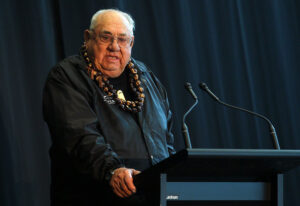About the project
On 17 August 2012, two traditional double-hulled Māori sailing canoes – built by internationally respected Hekenukumai Puhipi (Hector Busby) – departed Auckland and sailed 10,000 nautical miles return to Rapa Nui (Easter Island) before returning to Doubtless Bay on the east coast of the Northland Region.
The objective of Waka Tapu was to close the final corner of the Polynesian Triangle – defined by Hawaii in the North, New Zealand in the South-West and Rapa Nui in the East. This was the first time this voyage had been completed in modern-day history. As a result, the principal waka, Te Aurere, was consecrated or made ‘tapu’, hence the project name – Waka Tapu. The voyage was unassisted by modern technology, the navigators guided only by the habits of the stars, sun, currents, birds and moon. The historic expedition was organised by NZMACI in partnership with Te Tai Tokerau Tārai Waka Inc.and supported by Te Puia <<link to website>> – the tourism arm of NZMACI.
Concept & Development
The first seeds of Waka Tapu began in December 1985, when the Hawaiian voyaging waka Hōkūle’a sailed into Waitangi Harbour, witnessed by master waka builder Hekenukumai (Hector) Busby. The visit inspired him to build a similar vessel, Te Aurere, which left on its maiden voyage to Rarotonga in 1992.
Then, in March 1995, it led a fleet of waka to Taputapuātea Marae on the island of Raiātea, Tahiti. It then became Hekenukumai’s dream to reach the final corner of the Polynesian Triangle and re-establish ancient genealogical connections.
In August 2012, the Waka Tapu voyage left New Zealand, with the crew using only the sun, stars, moon, currents and marine life to guide their way. Te Aurere was the principal waka on the voyage, supported by Hekenukumai’s second waka hourua (double hulled canoe), Ngahiraka Mai Tawhiti.
The waka landed in Rapa Nui on 6 December 2012 and, in May 2013, both waka returned to Doubtless Bay on the east coast of the Northland Region of New Zealand, coinciding with the opening of NZMACI’s fourth school, Te Wānanga-a-Kupe Mai Tawhiti (The National Waka Building School).
The school’s students are in the process of restoring Te Aurere – the principal waka hourua that was used in the voyage.
Kōrero (narrative)
Te Aurere
Since the early 1990s, Te Aurere has become an international symbol for cultural revitalisation and connectivity for peoples throughout the Pacific Ocean. Te Aurere has sailed over 30,000 nautical miles, visiting Hawaii, French Polynesia, the Cook Islands, New Caledonia and Norfolk Island, as well as making countless circumnavigations of the North Island of New Zealand.
Ngahiraka Mai Tawhiti
In 2000, Hekenukumai began the build of a second waka hourua (double hulled canoe), Ngahiraka Mai Tawhiti, named after his late wife, with a view to ‘closing the Polynesian Triangle’ by sailing to Rapa Nui (Easter Island) and supporting Te Aurere on the Waka Tapu voyage.
Project Facts
- 20 years in the making
- 2 waka hourua traditional double hulled sailing canoes
- 17.5 metres long
- 7 – 11 tonnes of kauri
- 10,000 nautical miles
- 10 months at sea
- 60 people involved in total
- 18 – 67 years age range of participants
- 10 – 12 sailors on board each waka at any one time
Partners
TE TAI TOKERAU TĀRAI WAKA INCORPORATED
Te Tai Tokerau Tārai Waka Inc.was established in the late 1980s for the purpose of ensuring the mana (pride/prestidge) of kaupapa waka, including sailing, paddling and ocean voyaging, was maintained throughout the Pacific and the world through advocacy and education. The survival and renaissance of kaupapa waka in New Zealand can be attributed to their efforts over the past 20+ years.
SUPPORTERS
- Te Puia
- Creative New Zealand
- Te Puni Kōkiri
PROJECT MEMBERS

Hekenukumai Puhipi (Hector Busby)
Hekenukumai (Hec) is a traditional navigator from Northland who is highly regarded around the world for his contribution to kaupapa waka (canoe practices).He was initially inspired by Pinky and Nainoa Thompson, the navigators of the Hōkūle‘a, a replica of a traditional Hawaiian canoe which voyaged to New Zealand in 1985. He was trained to navigate by Micronesian navigator, Mau Piailug.
For his services to the community, Hec received the New Zealand Commemoration Medal in 1990 and, in the 1994 Queen’s Birthday Honours, he was made a Member of the Order of the British Empire (MBE) for services to Māori.
Hec was again recognised for his services to Māori on the 2014 New Year Honours List, where he was appointed an Officer of the New Zealand Order of Merit (ONZM) – a fitting and appropriate acknowledgement of his contribution to Māori cultural development.
